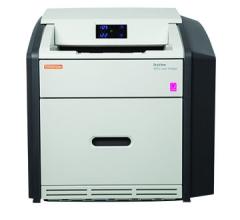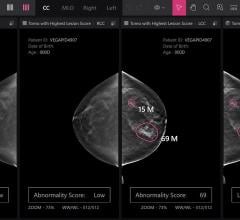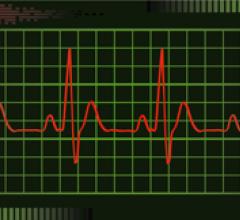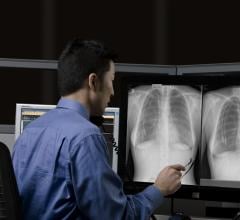Carestream showed its new DryView 5950 Laser Imaging System that produces 508 pixels-per-inch output for general radiology and mammography images.
Acuo Technologies said the Defense Logistics Agency of the U.S. Department of Defense (DoD) selected the Acuo Universal Clinical Platform (UCP) as a new vendor neutral archive (VNA) solution for enterprise patient imaging logistics. UCP will consolidate imaging studies from 39 U.S. Army picture archiving and communication system (PACS) sites and 23 U.S. Navy PACS sites located at military healthcare facilities throughout the world.
Hologic will feature its Selenia and Selenia Dimensions 2D mammography systems at RSNA, which continue to be recognized as the standard-bearers for the industry, ranking second and third, respectively, in the digital mammography category in the KLAS 2012 annual survey of healthcare executives and clinicians.
Radiology departments have many different needs and face a wide variety of challenges that can impact their departments ...
Nov. 15, 2012 (GLOBE NEWSWIRE) -- Merge Healthcare Incorporated (Nasdaq:MRGE), a leading provider of clinical systems and innovations that seek to transform healthcare, will unveil a national mobile and internet platform for consumers and demonstrate how enterprise imaging solutions support achieving Meaningful Use objectives at the Radiological Society of North America (RSNA) in booth #4845.
Hologic, Inc. will feature at RSNA this year its Selenia Dimensions 3D mammography (breast tomosynthesis) system. The technology was approved by the U.S. Food and Drug Administration (FDA) in February 2011 and has been available in countries recognizing the CE mark since 2008. Hologic’s 3D mammography technology is available in 46 states and 29 countries outside the U.S.
The annual Transcatheter Cardiovascular Therapeutics meeting is a key source of the latest clinical trial data on new stent technologies. Two key trials were presented, published in the Cardiology Journal, each using transcatheter patent foramen ovale (PFO) closure to prevent cryptogenic strokes.
Despite decades of progress in breast imaging, one challenge continues to test even the most skilled radiologists ...
The American Institute of Ultrasound in Medicine (AIUM) will recognize The American Registry of Radiologic Technologists’ (ARRT) general sonography certification earned by individuals after Jan. 1, 2013, as an accepted credential for sonographers in practices accredited by AIUM in general abdominal, obstetrics and/or gynecologic ultrasound. Sonographers earning ARRT’s general sonography certification – R.T.(S)(ARRT) – after that date will satisfy AIUM practice accreditation standards
Matrox Xenia Series display controller boards will power five separate solutions at the 2012 annual meeting of the Radiological Society of North America (RSNA). Designed for medical imaging professionals, Xenia Series has applications in computed radiography (CR), digital radiography (DR) and picture archive and communications system (PACS) diagnostic workstations and will be demonstrated at various Matrox partners’ exhibits.
November 14, 2012 — Vital Images received 510(k) clearance from the U.S. Food and Drug Administration (FDA) for 3-D viewing through its universal viewer, VitreaView. The company also released tablet viewing capabilities for VitreaView.
Bayer Radiology’s Barbara Ruhland and Thom Kinst discuss how radiology departments can address the many different ...
The annual Transcatheter Cardiovascular Therapeutics meeting is a key source of the latest clinical trial data on new stent technologies. Two key trials were presented, published in the Cardiology Journal, each using transcatheter patent foramen ovale (PFO) closure to prevent cryptogenic strokes.
Magnetic resonance imaging (MRI) is more effective than electrocardiography (ECG) at identifying "silent" heart attacks, also known as unrecognized myocardial infarctions, according to a study performed by National Institutes of Health researchers and international colleagues.
November 14, 2012 — Two years after the joint launch of Optima MR360 and Brivo MR355, GE Healthcare announced a major milestone with the 500th shipment of these products combined, making the duo one of the fastest in GE MR (magnetic resonance) history to reach this milestone. This GE exclusive combines the speed and high resolution of an ultra-high field system with the breadth of imaging capabilities that increase the versatility of the system.
eHealth Saskatchewan plays a vital role in providing IT services to patients, health care providers, and partners such ...
Fovia Inc., the developer of High Definition Volume Rendering and a world leader in imaging technology, today announced the release of HDVR Mobile, providing anytime, anywhere access to medical and dental 3-D applications. Following the success of Fovia’s HDVR Connect, Fovia’s HDVR Mobile allows original equipment manufacturers to easily integrate and distribute advanced visualization applications on mobile devices.
November 14, 2012 — Belk, the nation's largest privately operated department store, is launching the BelkGives On The Go Mobile Mammography Center in partnership with Charlotte Radiology and Foundation For The Carolinas. This mobile mammography center will bring testing and awareness to all Belk markets, beginning in 116 stores throughout North Carolina, South Carolina and Tennessee.
November 14, 2012 — Philips has launched in China the first ever digital broadband MR, Ingenia. At a launch ceremony themed “Definition of Digital MR, The Future of Imaging” hundreds of foreign and Chinese experts and scholars in imaging and clinical applications gathered together to discuss the digitization trend of MR (magnetic resonance) and the clinical performance of Ingenia in neuro, body and cardiac applications.
November 14, 2012 — BridgeHead Software announced its file archiving data and storage management system for PACS (picture archiving and communication system) image data protection has been successfully tested by Fujifilm at a leading U.S. hospital.
Flow by Intelerad features a unified interface, intelligent worklists, structured reporting with voice recognition, and embedded subspecialty tools, and is a comprehensive enterprise diagnostic solution. Built on Intelerad’s robust Web-enabled architecture, Flow provides radiologists with high-performance access to studies from any location, empowering teams to deliver quality results smarter, faster.
Imaging Technology News talks to Mark Watson, executive director of the Radiological Society of North America (RSNA) ...
The somo•v automated breast ultrasound (ABUS) system is the only ultrasound device specifically approved for screening women with dense breast tissue. Used in combination with mammography, the system is clinically proven to increase cancer detection rate in women with dense breast tissue by 30 percent.
The new Pixium 3543 EZ is the lightest WiFi portable detector for radiography, designed to facilitate exam conditions. Featuring a standard cassette format, it operates for 8 hours (exchangeable battery). It is intended for use with all systems — table, wall stand or mobile — as well as for transforming analogical or computed radiography (CR) systems into digital.


 November 19, 2012
November 19, 2012 












